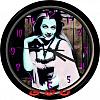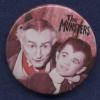|
THE MUNSTERS COLLECTIBLES #01 |
Updated: January 06, 2020



































































































The Munsters was developed, written, and produced by Joe Connelly
and Bob Mosher, both writers for The Amos & Andy Show who teamed
up to create, write and produce Leave It to Beaver. The Munsters
debuted on CBS on September 24, 1964 and completed its original
prime-time run on September 1, 1966.
Arriving in American homes at a time when classic horror characters
were in vogue with audiences, The Munsters celebrated the macabre
humor of ghoulish creatures with wisecracking dialogue, outrageous
visual gags and fast motion photography. The series revolves around
a loving family of misfits who reside in a spooky cobweb-filled
house at 1313 Mockingbird Lane in Mockingbird Heights. The head of
the family, kindhearted Herman Munster (Fred Gwynne), bears a close
resemblance to the Frankenstein monster as originally portrayed by
Boris Karloff. His wife Lily (Yvonne DeCarlo) resembles Vampira,
TV's creepy-but-sexy hostess of horror. Lily's father, Grandpa (Al
Lewis), is actually Count Dracula from Transylvania. Herman and
Lily's son, Eddie (Butch Patrick), looks like a junior wolfman. The
final member of their household is Herman and Lily's niece, Marilyn
(played first by Beverly Owen and then by Pat Priest), who is
considered the ugly duckling of the family although she is a
beautiful, blonde, all-American teenager.
Just as important as the characters are the family cars, Herman's
Munster Koach and Grandpa's Dragula. These vehicles were designed by custom car King George Barris, who also created the Batmobile and
the Monkee Mobile. All four of these became big-selling toy models
when their shows were first broadcast. Episodes of The Munsters
generally deal with the difficulty of trying to be a solid,
upstanding family of decent citizens when everyone in the outside
world reacts to you with horror. The Munsters is similar to The
Addams Family, a contemporary series about a bizarre family.
Clearly, American television was trying to make a statement about
nonconformism, an issue which would become increasingly important as
the counterculture moved into mainstream America during the late
1960's. Shown here are just a few of the many collectibles released
during the TV series.
|
 HOME
HOME
 About
About
 EMail Me
EMail Me TOP |
TOP |  PREVIOUS ITEM | NEXT ITEM
PREVIOUS ITEM | NEXT ITEM  ( 25 of 102 )
( 25 of 102 )



































































































